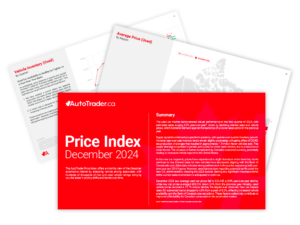Despite challenges stemming from the global microchip shortage, silver linings may be found by dealers who can influence car shoppers not to look elsewhere in the face of extended wait times
As the global microchip shortage continues to delay the production of new vehicles, AutoTrader.ca recently deployed a national survey of Canadian car shoppers to get a full picture of the importance of new vehicle delivery timeframes. The survey set out to gauge just how long consumers are willing to wait for that perfect car, and if they are now more open to the influence of advertising for another automotive brand or model if the vehicle they want is out of stock or delayed.
According to the survey, conducted online in August of this year among 453 adult Canadians who had indicated they were open to purchasing a new car within the next 12 months, vehicle availability and delivery time is, as expected, very important to overall purchase intent.
Key findings indicate that two out of three Canadian car shoppers believe vehicle delivery timeframe and availability is either “important” or “very important” when it comes to their overall purchase decision. Only a small percentage – five percent – of respondents said it wasn’t important at all.
However, while consumers are willing to extend wait times to get into their preferred vehicle, many indicate they would consider switching manufacturer or model preference if they find the duration between purchase and delivery to be too long.
Car Shoppers Expect to be Driving Sooner Than Later
A full 80 per cent of respondents to the study said they would generally expect to be behind the wheel of their new car within one month of purchase. Only 20 per cent of respondents said they would typically expect to wait more than a month to get the keys to their new vehicle.
With the realities of today’s supply-chain challenged market, these consumer expectations are being tested and dealerships are being challenged to meet them.
As indications across the industry show new car buyers waiting anywhere from a few weeks to six months or more to have their vehicle delivered, it might not be surprising that some car shoppers would consider revisiting their preferences or even forsaking their brand loyalty in favor of getting the keys sooner.
Of car shoppers surveyed, 16 per cent of respondents said they would consider switching to another vehicle if their first choice wasn’t immediately available, even when the alternative might actually be their second or third choice.
Top Preferences Hold
According to the AutoTrader.ca survey, 42 per cent of shoppers would wait until a later date to buy their most preferred vehicle if it was out of stock or its delivery was known to be significantly postponed. At the same time, 22 per cent of respondents, faced with not being able to immediately get their preferred vehicle, would hold off on buying any new vehicle, opting to wait until the overall new car market had more available inventory.
This indicates that 64 per cent of car shoppers would rather wait at least some time for inventory to become available rather than compromise on their preferred vehicle.
Underscoring how committed some Canadian car shoppers are to the primary car brand and model they have in their sights, 18 per cent would consider buying a used model of their top car choice and get it right away versus switch models or cross shop competing manufacturers.
How Long Will Car Shoppers Wait?
Among car shoppers who would be willing to wait to buy their preferred model if it wasn’t immediately available, 43 per cent said they would be willing to wait less than three months, nearly one in three (31 per cent) said they would be willing to wait between four to six months and one quarter (25 per cent) said they would be willing to wait more than six months to get into the right vehicle. That means that more than half (56 per cent) of loyal car shoppers would be willing to wait anywhere from four months to more than a year to get their vehicle of choice.
Right Time for Targeted Marketing
Having a clear understanding of these prospective customer segments can set up some interesting opportunities for a variety of marketing efforts by dealers. This may include developing ways to gauge – and potentially influence – a prospect’s shift in purchase intent while they wait for their preferred vehicle to become available or, in contrast, reinforce that decision for when the vehicle does eventually become available.
To this end, more than half (52 percent) of ‘brand loyalists’ who indicated they would be willing to hold on for their preferred vehicle, said they would still be open to switching car brands or models while they wait. Further, one in four (24 per cent), said they may be open to advertising that proposes considerations from an alternative auto manufacturer. This 24 percent could even be an under representation given consumers typically under estimate the influence advertising overall.
Maintain Dialogue With Loyal Customers
Despite challenges facing the new car market, a delayed vehicle delivery can be viewed as an opportunity for car dealerships. Establishing and nurturing an ongoing dialogue with motivated car buyers, who are generally inclined to be loyal, is key as they could potentially be lost to another dealership or brand if the line of communication is broken.
In fact, even after a deal has been signed, maintaining ongoing communication with the customer gives dealerships a pulse as to whether or not the buyer may be getting agitated with their wait and if long-term brand loyalty could be tested. Knowing the mindset of the customer puts the dealership in a much better position to proactively take steps to maintain customer satisfaction and loyalty. Of course, speed of response and flexibility are paramount.
While there are some cautionary notes that can be drawn from the study, the clear upside is that dealers should feel confident that a strong, proactive marketing and communications plan that directly addresses the delivery challenges created by the global microchip shortage, while offering outstanding customer service to intending car buyers, can be a winning strategy – particularly if it includes the following elements:
- Don’t let up on your advertising. Keep your ad dollars working for you, so you can act on opportunities to move prospective customers into an alternate nameplate, (particularly the case with network dealerships), into another model, or even used inventory.
- Ramp up your customer service, with a focus on flexibility. Nothing will give you more of a competitive edge than demonstrating a willingness to adapt your processes to keep the customer content and informed during the current supply chain crunch. A customer service program built and focused on keeping the customer happy while they await delivery is a surefire loyalty builder.
- Activate a strategic communications plan that extends from the moment a purchase contract is signed to when the keys are handed over. Open and transparent dialogue can be the difference maker in identifying signals that a customer is getting concerned or agitated. The ability to respond quickly and meaningfully is key to keeping the sale.











